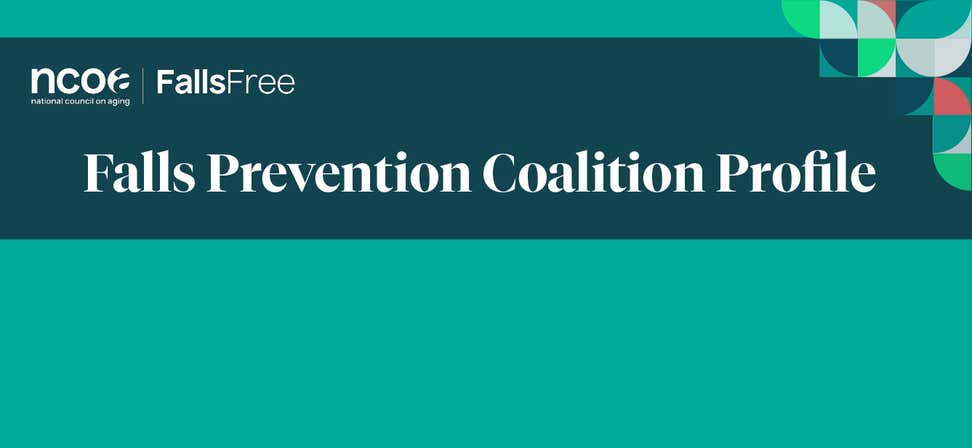Wisconsin's Falls Prevention Coalition brings together stakeholders from many fields to address the high rate of falls among older adults in the state.
The history of the Falls Free Wisconsin Coalition
In 1999, Age Advantage (an agency that worked with county aging units in Southern Wisconsin) contacted what was then the Wisconsin Department of Health and Family Services Injury Prevention Section Chief to talk about the magnitude of elderly falls in Wisconsin. After this meeting, additional stakeholders were identified and invited to meet to talk about this problem, to identify activities and resources already in place and to share any other pertinent information.
Data was reviewed showing Wisconsin having the second highest rate of deaths from falls in the country at that time. In an effort to reverse the reported trend in CDC data, the Wisconsin Falls Prevention Initiative (FPI)—an interdisciplinary statewide coalition—was created to address falls, fall prevention and fear of falling in a systematic manner. Due to staffing challenges, the FPI has evolved to its latest iteration—the Falls Free Wisconsin Coalition—launched in 2021 with leadership from the Wisconsin Institute for Healthy Aging. The group continues to employ a collective impact approach to falls prevention with representation from aging services, public health, public safety and health care providers.
Current goals and objectives for the Falls Free Wisconsin Coalition
The Falls Free Wisconsin Coalition is committed to reducing falls among older adults in Wisconsin using a collective impact approach.
Goals
- Ensure public awareness of and access to evidence-based and evidence-informed falls prevention programs and practices for all people.
- Strengthen and grow falls prevention within coalitions in Wisconsin.
- Develop data sharing capacity and customization.
- Develop public policy agenda.
- Grow membership of the coalition and ensure coalition is representative of the communities we serve.
Objectives:
- Improve participation in existing programs.
- Improve screening at clinical levels that lead to interventions.
- Develop innovative interactive tools and resources to engage target audiences.
- Develop brand identity for coalitions.
- Disseminate Falls Coalition Quick Guide.
- Increase the number of local falls coalitions/falls emphasis in local coalitions.
- Disaggregate data by priority/underserved populations.
- Develop examples/templates of how to use data for communities.
Leadership for Falls Free Wisconsin
Organizations that currently lead coalition efforts:
- Suzanne Morley, Falls Prevention Program Coordinator, Wisconsin Institute for Healthy Aging suzanne.morley@wihealthyaging.org
Key Partners for the Falls Free Wisconsin Coalition
- Froedert
- The Medical College of Wisconsin
- UW Health
- Safe Communities of Madison and Dane County
- Wisconsin Department of Health Services
- Advocate Aurora Health
- ADRC of Brown County
- Greater Wisconsin Agency on Aging Resources, Inc.
- Inclusa
- iCare Health Plan
- Oshkosh Fire Department
- Green Bay Metro Fire Department
- Community Living Alliance
- Casa ALBA Melanie
- Monroe County ADRC
- TMG
- SSM Health
- Mayville EMS
- Greendale Health Department
- Greenfield Health Department
- Greenfield Rehabilitation Agency, Inc.
- ADRC of Central Wisconsin
- Jackson County Public Health
- ADRC of Fond du Lac County
- Health and Human Services Sheboygan County
- CORE Community Resources
- YMCA of the Fox Cities
- Revitalize Milwaukee
- Trempealeau County ADRC
- ADRC of Portage County
- De Pere Health Department
- Ascension-Elmbrook Memorial Hospital
- ProHealth Care
- Kenosha County ADRC
- City of Brookfield Fire Department
- Oshkosh Seniors Center
- Gundersen Health System
- Marshfield Clinic Health System
- Waukesha County ADRC
- Shawano County Human Services – Aging Unit
- Manitowoc County Health Department
What has the Falls Free Wisconsin Coalition achieved?
- Developed and released the Falls Free Wisconsin Coalition Quick Guide to help support local falls prevention coalitions throughout Wisconsin.
- Secured proclamation from WI Governor declaring September Falls Prevention Awareness Month.
- Earmark funding secured to establish the Falls Free Wisconsin Center.
What are the current challenges for the Falls Free Wisconsin Coalition?
- Securing base funding in the state budget to support older adult falls prevention.
- Staffing capacity remains limited post-pandemic.
What evidence-based falls prevention programs are currently offered by the Falls Free Wisconsin Coalition?
What outcomes are monitored by the Falls Free Wisconsin Coalition?
- Increase in supply of and participation in evidence-based falls prevention programs.
- Increase in local falls prevention coalitions.
- Upon the launch of the FFWI Center, increase FFWI web traffic and social media engagement.








